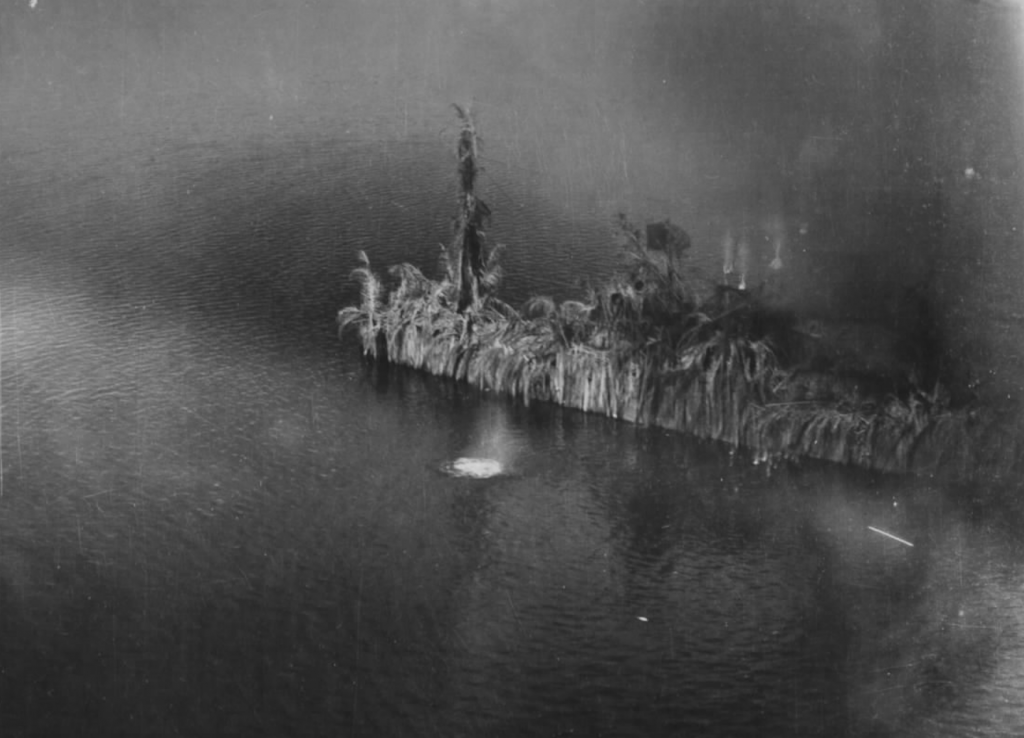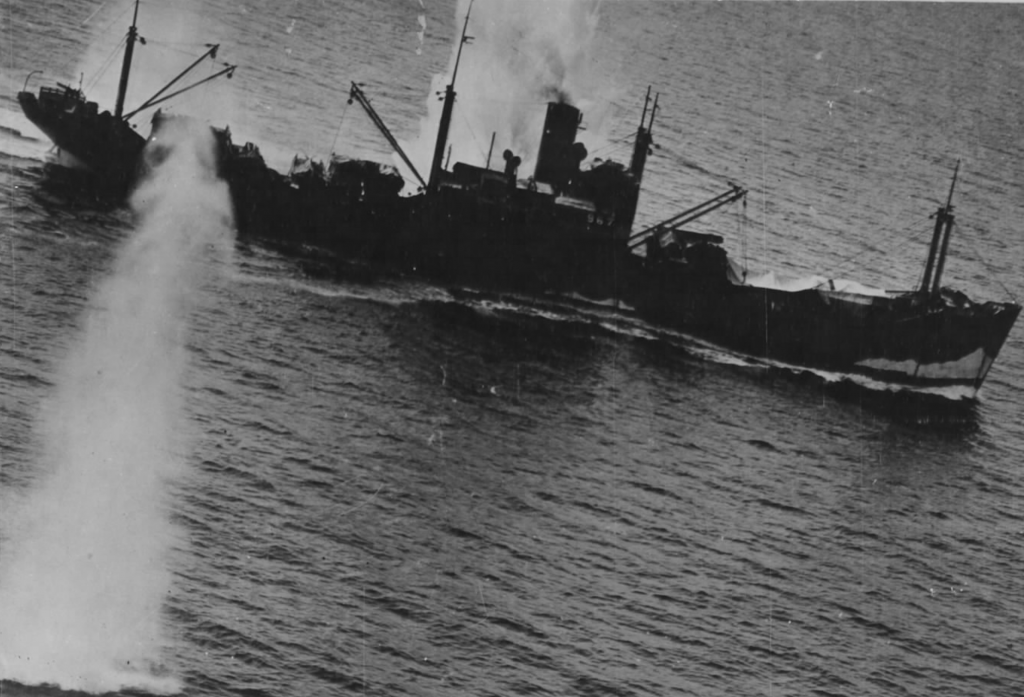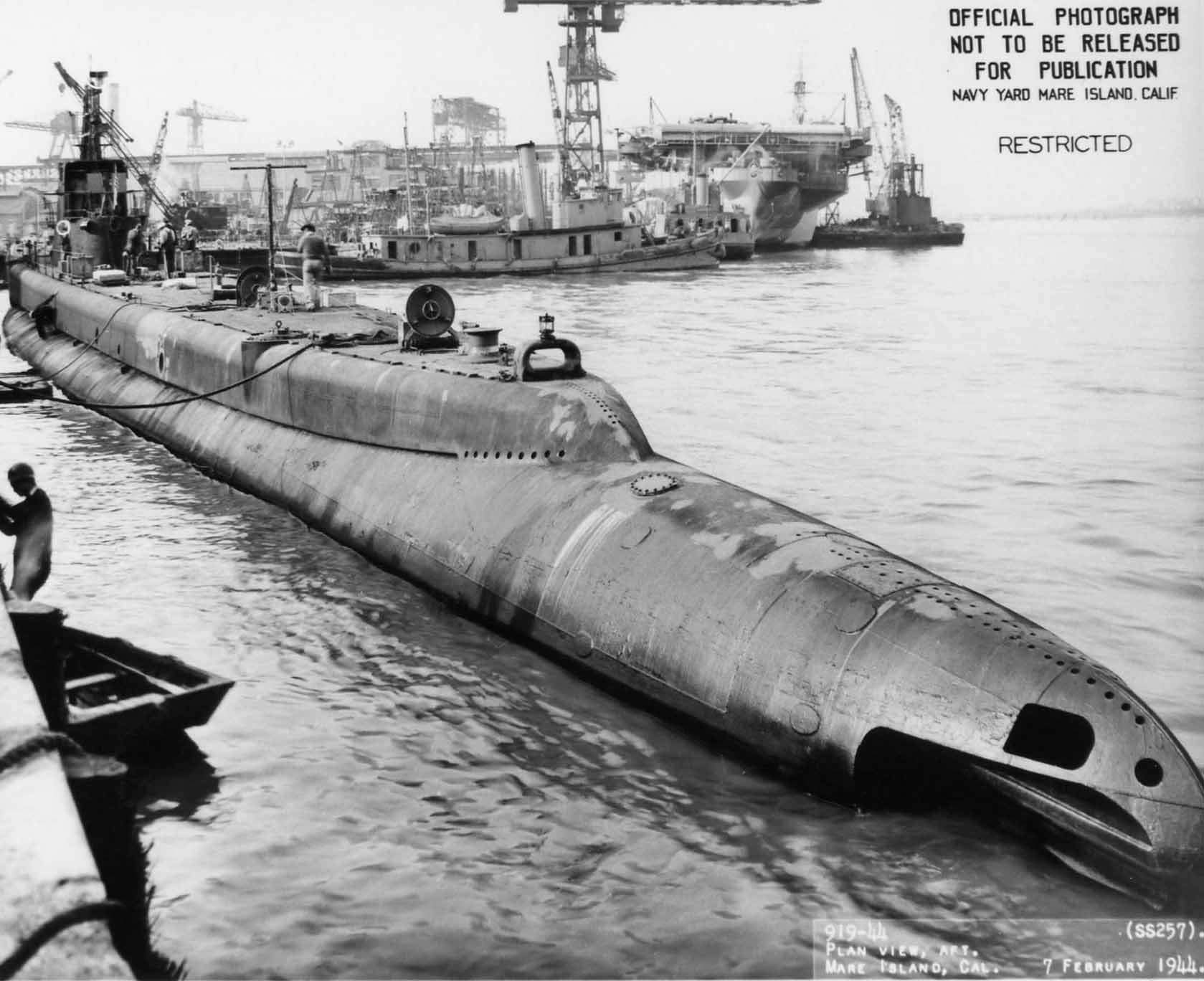The Battle of the Bismarck Sea was a pivotal WWII battle fought March 2-4, 1943, in the Southwest Pacific Area (SWPA). Allied aircraft from the US Fifth Airforce and the Royal Australian Air Force (RAAF) attacked a convoy of Japanese ships transporting troop reinforcements to Lae, New Guinea. The Allies destroyed most of the convoy, and Japan suffered heavy losses, abandoning their plan to land more troops at Lae.
In January 1943, Japan launched a convoy of five destroyers and five transport ships to New Guinea to reinforce the Japanese hold in the SWPA. Allied aircraft attacked the convoy, but only two transports were lost. Some 4,000 Japanese troops successfully made it to New Guinea.

Emboldened by their success, Japan began planning a more extensive transport to bring 6,900 troops, ammunition, fuel, and supplies to reinforce New Guinea. They knew the convoy was risky because of strong Allied air power, but the alternative was landing the troops much further away, where they would be required to hike through rugged terrain to reach Lae.
The second Japanese convoy consisted of eight destroyers, eight transports, and 100 Japanese aircraft to provide air cover. The convoy departed Simpson Harbour in Rabaul on February 28, 1943.
Allied intelligence officials, however, had intercepted coded Japanese messages and were aware of the plans for a convoy. Under the direction of US Army Lt. Gen. George C. Kenney and RAAF Group Captain William H. Garing, the Allies planned and rehearsed a highly coordinated air attack. Reconnaissance planes began sweeping the sea, looking for enemy ships. On March 2, they spotted the enemy convoy and launched the first of several waves of attacks.
The multi-pronged attacks involved 16 Allied squadrons that attacked from different altitudes. Some bombers flew just a few feet above the ground, dropping skip bombs (bombs that skipped across the water before slamming into the sides of ships). Others from medium altitude and some from as high as 10,000 feet.
Over the next two days, the Allies sank all eight transports and four destroyers. The remaining four destroyers were damaged. They also shot down numerous Japanese fighter planes. Japanese survivors from the ships were adrift in the sea. On March 4, the Allies sent torpedo boats and aircraft to patrol the area. They strafed Japanese survivors and rescue vessels. They also engaged with a Japanese submarine, assisting in the rescue operation. The controversial strafing decision was defended as a way to prevent enemy soldiers from returning to active service.
At least 3,000 Japanese soldiers died. Some 2,700 were rescued from the water and returned to Rabaul, and 1,200 made it ashore to Lai. In contrast, just 13 Allied airmen died. The losses were devastating for Japan, and they made no further attempt to reinforce Lai.
If you would like to learn more about the Battle of the Bismarck Sea, search Fold3® today.







Great article. I enjoy reading about history!
My uncle Charles Lewis was a navigator on a B17 that was on fire but made it back to base. He received a silver star.
I wrote an article about this for one of the World War II magazines several years ago. Most of the transports and destroyers were sunk or damaged by modified A-20 and B-25 strafers that had recently been converted into gunships by Major Paul I “Pappy” Gunn. Major Ed Larner led the B-25s in the attack. The gunships strafed the decks of the ships as they made their skip-bombing attacks. The medium bombers and B-17s didn’t do much but splash water. The Navy was incensed when they found out what the Army bombers had done and mounted criticism that continues to this day. The attack was a turning point, if not THE turning point in the war in the Pacific.
Thanks for sharing, Sam!
Why was Navy incensed, Army inaccurate bombing?
My father was a navigator with the 13th Grim Reapers, the very first mission he flew was that strafing of survivors. Nothing to be proud of but it was war, a point he made once during the Iraq War.
Thank you for this article. My dad, Robert Reed, was a B-25 pilot in this battle at age 24. His stories of the skip bombing were so harrowing. I’m amazed his crew survived. I was in the WWII Museum in New Orleans yesterday, 81 years later! Coincidence!
My dad was a B-17/B-24 pilot in the 5th Air Force, and was awarded the Silver Star for his action in the Battle of the Bismarck Sea. He never talked about what he actually did. I have a copy of the original award citation.
“Gregory G. Dobfenchuk, Captain, 90th Bomb Group, 400th Bomb Squadron, Air Corps, U.S. Army. For gallantry in action over the Bismarck Sea near Lae, New Guinea on March 3 1943.”
My father was a US Navy 2nd Lieutenant and gunnery officer on the Lurline (converted to a troop carrier), running between Adelaide AUS and Port Moresby, New Guinea. The only “action” that he ever told me about was the time he took a walk, I would guess in some jungle outside of Port Moresby. He had an encounter with a head-hunter, but got away from him by offering him a fresh pack of cigarettes. He spent a significant amount of time in a San Diego hospital, having caught some sort of Jungle Fever. I was born in St. Louis 3.5 weeks after the Bismarck Sea Battle, and my dad got his first look at me perhaps 6 month later in San Diego. He never told me any other stories of his time in the Navy…
Unmentioned in the above account is an event that resulted in the ferocity of the Army Air Force. As recorded by James Duffy in his book “War at the End of the World” a B-17, the Double Trouble, piloted by Lt. Woodrow W. Moore, collided with a Zero. As seven members of the bomber crew parachuted down several Zeros gunned them down as they floated helplessly down. This was observed by crews of other American bombers. Intent on revenge American planes returned to bomb survivors. PT boats machine-gunned Japanese in the water that night.
My father was a S/Sgt with the 41st Infantry Division in New Guinea. He wrote of his war experiences. He recalled the continuous flights of planes on these days and those that returned smoking after being hit by Japanese fighters. As to the bloodbath that took place few know how brutal the fighting was in New Guinea. There was no quarter given. The Japanese rarely surrendered. They might pretend to surrender but then attack you. They practiced bayoneting on captured enemy. My father saw cannibalism.
The Beaufighters were equiped with both canons and machine guns. When they flew towards the Japanese ships they then turned to face the oncoming aircraft thinking they were Torpedo Bombers. Instead the Beaus opened up on the bridges of those ships and raked them with a blistering attack from their 4 X 20MM Canons and 6 X .303 Machine guns in most cases killing the commander and other officers on the bridge. Leaving them with out officers in charge
Thank you for this history. I never knew the details and realize how fortunate we were in those soldiers being successful at defending our country from an invader.
We owe a lot to those leaders for their strategy and those airmen who flew those raids.
IT IS HARD TO IMAGINE THE USA STRAFING THE HELPLESS VICTIMS (JAPANESE) IN THE WATER …
I GUESS AFTER LEARNING HOW THE JAPANESE TREATED OUR PRISONERS , THE STRAFING WAS JUSTIFIED …….
Understanding why something was done is not the same as justifying it.
In his book WAR AT THE END OF THE WORLD about the war in New Guinea historian James P. Duffy relates an event that led to the Army Air Force’s relentless attack on the Japanese in the water following the sinking of their transports. One attacking B-17, the Double Trouble, collided with a JapaneseZero fighter. As seven members of the flight crew of the Double Trouble parachuted helplessly down they were attacked and killed by several Zeros. This was witnessed by other American bomber crews. This led to the ongoing attack of the Japanese survivors.
My father was fighting with the 41st Infantry Division in New Guinea. He observed the bombers and fighters flying over to attack and some returning in smoke having been hit by Japanese fighters. He witnessed firsthand the ferocity and barbarity of the Japanese soldiers. They rarely surrendered and would fake a surrender and then attack. At the generally unknown “Hospital Lot” event but infamous among 41sters Japanese soldiers hid among sick and dead soldiers and attacked American soldiers. The Japanese would conduct bayonet practice on prisoners. The Japanese did practice cannibalism. My father saw flesh of his fellow soldiers cooking in pots in campsites that his platoon overran. These are facts. American fliers at Port Moresby and other airfields guarded by infantry in New Guinea had heard these stories. Navy pilots had not. Every Japanese soldier killed in the Bismarck Sea was one that did not have to be faced by American and Australian infantry inland. My Dad hated war. In his memoirs he stated he would not now do any harm to the Japanese, but he could not forget the misery they caused him including the death of his best friend.
My father was a navigator gunner for the Navy in the Pacific. He told me a story that I have been trying to put in some context and verify. He said that the Navy was searching for the Japanese fleet and five planes, his among them, were sent out to search. They found the fleet, but only his plane made it back, whereas the others were lost, with 28 men. However, finding the fleet allowed them to have a great victory. He called it “MacArthur crossing the T”, but I am not sure if he has this correct, although I am sure that his account of the search and lost planes is largely accurate. Anyway, does anyone recognize this battle, where the Japanese fleet was soundly defeated? Could it be this battle?
Hi Ava,
The Battle of the Sea of Bismark is probably not the one your father told you about. His comment about “MacArthur Crossing the T” makes me believe it was the Battle of Surigao Strait which was part of the Battle of the Leyte Gulf. His recollection of a great victory is accurate.
Here is a link to info about the Battle of the Leyte Gulf.
https://warfarehistorynetwork.com/article/the-battle-of-leyte-gulf-oldendorfs-textbook-crossing-the-t/
About half way through this article, there is a part labeled
“Musashi’s Downfall”
The paragraph below that regarding TG38.4 may be about your father’s recollections (in CAPS).
“On the morning of the 24th, planes from Bogan’s TG 38.2 spotted Kurita’s force steaming through the Sibuyan Sea toward San Bernardino Strait. AT THE SAME TIME, PLANES FROM DAVIDSON’S TG 38.4 FOUND NISHIMURA’S SOUTHERN FORCE AS IT MANEUVERED THROUGH THE SULUS SEA. Shima’s Southern Force was spotted by land-based Fifth Air Force planes based on Owi, Biak, and Noemfoor.”
Spotting of Nishimura’s Southern Force led to the Battle of Surigao Strait and the “Crossing the T”
About 3/4 through the article there is a nice map showing the area and some of the naval force movements.
On a personal note, it was odd to your father’s reference to “MacArthur’s Crossing-the-T”. A couple of weeks ago, I saw that same reference in a Pacific Naval action fiction book by P.T. Deutermann. I have never seen any other similar reference.
The article in the above link has few if any reference to MacArthur. He was the General in charge of the land forces at that time. He really had little or no part in the naval actions. I suspect MacArthur’s Public Relations folks saw a great victory and found a way to attach his name to it. I am sure the Naval historians made sure MacArthur did not get any credit for “Crossing the T” in their records.
Regarding th last paragraph in my earlier post. I have learned that the Admiral in charge of the fleet at the Battle of Surigao Strait did indeed report to General MacArthur. So I guess there is some reason for the term “MacArthur’s Crossing the T”. Still as I posted, I have only seen that reference twice.
Fold3 does an outstanding job on our military history. I was ten years of age when this action took place. Eight years later I was in the army, intelligence, and part of the German Occupation.
This comment is not about the above story but it made tears leak from my eyes.
I enlisted in the Navy in 1968. The first remembrance was that when I returned home that afternoon my Father handed me my draft notice. I served a year in Vietnam but I was behind a typewriter on a barracks barge that provided berthing and meals for costal and river boat crews. Many times I would look at returning boats that were full of bullet holes, body parts and blood. Many of my friends died over there and here from agent orange. My first cousin, who I grew up with, was drafted and fought in the contaminated jungles. To this day he has had multiple heart operations every year to keep him alive. I never wanted to ask him about what he did over there because one time I did ask someone and he got tears in his eyes and remained silent. My Father fought in France during WWII and I asked him once “how was over there”. He refused to say anything. I was chosen for an Honor Flight last year which was wonderful. I was later connected to a Dave Grogan who works for Univ. of Illinois but interviews veterans and posts their stories to his web site, Voices To Veterans. He interviewed me and wrote my story. I sent it to my cousin who loved it and contacted Dave then had his story told. I read about all the horrible times he had there but my cousin told me that he never mentioned a lot of the terrible ones. No wonder many veterans return home and after suffering the mental and physical after effects they take the own lives to be with God.
War is HELL and I’m sticking to it.
What about the USCG involvement?
Cutters MODOC, NORTHLAND and GENERAL GREENE.
My Grandfather was on General Green and was in the middle of the battle.
Great article. It adds flavour to a book I’m reading, Bob Leckie’s WELL ARMED MEN, which I highly recommend. He’s got great style and tells a well detailed story of the Pacific War. Bob also wrote A HELMUT FOR MY PILLOW.
Let the Veterans tell you what War is all about. There are no fair rules in War. Each Veteran knew very much that the moment he stops to ease up on his ability to measure the Enemy his life will be over in a split second. War is ” HELL “. Sad to say the World has yet to understand that Peace is the only way for Human Beings to survive on this Planet or we will all ” Perish ” the longer we wait to seek Peace with our neighboring Countries. Heaven help us if we don’t.
The crossing the T must be the part of the Battle of Leyte Gulf where battleships got to fight like battleships were designed to fight.
I’m researching my family history and recently came across name linked to my paternal family tree that has a connection to the Battle of the Bismark Sea. His name is William Raymond McCamy and he died 3 March 1943 during that battle. I found and visited his memorial at his family’s cemetery in Scottsboro, AL. His marker shows he was a 2d Lt, 43 AAF Bomb Group, 63 Squadron. Other online information shows he was aboard the B-17F “Double Trouble” as its navigator and was killed after bailing out. Not yet certain of the exact family blood line connection, but still looking in Ancestry.com records.
Also found out his older brother, James Alfred McCamy, was a 2d Lt, 303 AAF Bomb Group, 358 Squadron, aboard a B-17G as its bombardier who died 28 May 1944 during a raid on Rotha, Germany near Leipzig. His body was recovered after the war and is interred in the family cemetery that I visited.
These war stories are evidence of the brutality of war and the bravery of fighting men everywhere. My uncle was aboard the USS Lexington (“Lady Lex”) when she went down during the battle of the Coral Sea. From what I’ve read of that battle, I can only imagine (and don’t want to!) the terror that was experienced that fateful day. Rest in peace Baker 3rd Class Robert Leland (Rush) Whiteley. I wish I could’ve known you.